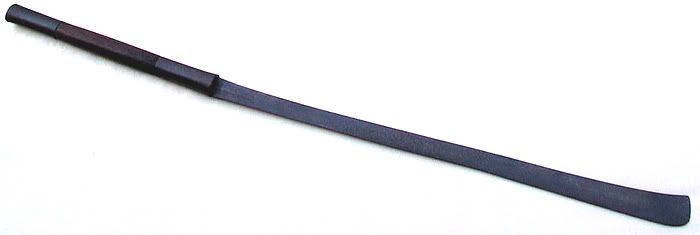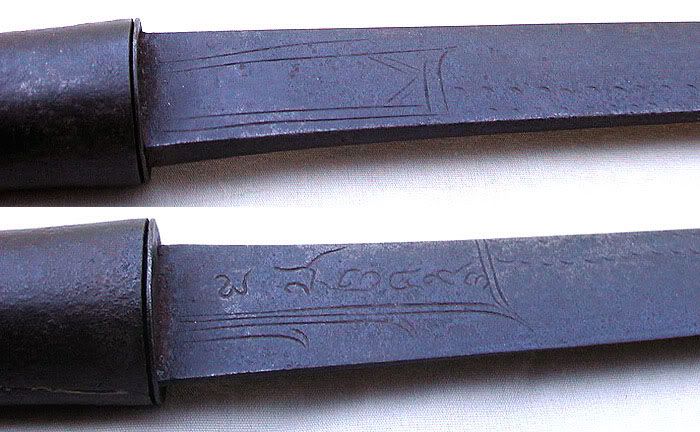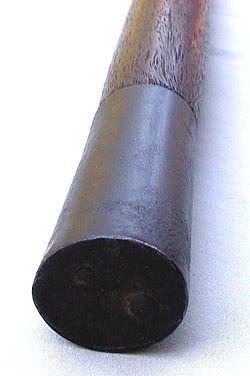
 |
|
|
#1 |
|
Member
Join Date: Jan 2005
Posts: 485
|
i'm not sure how early iconic references go with burmese swords, but i stumbled across these a short while ago. i hope they are relatively unknown, and of some use.
they are of the late 15thC, and show a dha-shaped blade with no guard, and a dha-shaped grip. the guys are warriors of mara, from the shwegugyi temple (erected in 1476). |
|
|

|
|
|
#2 |
|
Member
Join Date: Dec 2004
Posts: 987
|
Very interesting. I have not seen these before, and if the date is correct, they show a very early representation of a dha. It is funny that the demonic hosts seem to be the best source of actual contemporary weapons depictions. I have seen a number of daab being carried by Mara's minions in temple paintings from Thailand (much later, though). I guess the artists had freer rein in depicting the bad guys.

|
|
|

|
|
|
#3 |
|
Member
Join Date: Jan 2005
Posts: 485
|
hi mark,
i believe these have been well researched and so the date is more likely to be correct. yes, it is the same with indian art, in that there is a whole host of monstrous creations wielding the weapons we are desperatly trying to research. however far removed from reality the creatures were, the weapons seemed to be exremely realistic and so a great resource to benchmark dates and styles. apart from these, what is the earliest iconic reference for the dha-shaped sword? |
|
|

|
|
|
#4 |
|
Vikingsword Staff
Join Date: Dec 2004
Location: The Aussie Bush
Posts: 4,200
|
Interesting data. Thanks for the information. These are fairly wide bladed for dha, and quite short if these demonic figures are supposed to be of the same stature as ordinary Burmese. More of a chopper than a sword. They remind me of the length and width of Cambodian leaf-shaped blades from about the same period.
Ian. |
|
|

|
|
|
#5 |
|
Member
Join Date: Jan 2005
Posts: 485
|
i am pleased this is is of some use.
now, if any of you happen to be in the freer, with a camera, in the indian sculpture section.............  the description that accompanies these pieces are as follows - the pious king dhammaceti (r.1472-92) of pegu in lower burma built a series of temples to honour the life of buddha. the most distinguished was the temple complex of shwegugyi, erected in 1476. it was decorated with an extensive series of large-scale glazed tiles, many of which illustrated the demonic warriors of mara's army, sent to disrupt the buddha's meditation immediately prior to his enlightenment. this tile, with owl-headed figures bearing swords, is typical of this series. |
|
|

|
|
|
#6 |
|
Member
Join Date: Dec 2004
Posts: 987
|
My resources are very limited, since they are only what other people have decided to photograph. There are lots of daab seen in 18th-19C Thai temple paintings. Yours are the first of any kind that I have seen from Burma, but that likely just means I haven't read the right books.
The earliest dha depiction I have found is from Angkor Wat in Cambodia, but the date is disputed. Angkor Wat was built in the 12th C, but many of the carvings were done. At least one authority believes this freize was carved in the 14th C, by Siamese artists following 12th C style books. What is doubly is that it shows mak as well. 
|
|
|

|
|
|
#7 |
|
Member
Join Date: Jan 2005
Posts: 485
|
hi mark,
a fantastic image!! if the temple (?) was built in the 12thC, there must be a known date when it ceased to be added to. was this long past the 14thC? |
|
|

|
|
|
#8 |
|
Member
Join Date: Dec 2004
Posts: 987
|
I will have to go back and re-read my book. The carvings were done in two periods, one in Suryavarman's time, and the other a couple generations later. I'll get back to you on that.

|
|
|

|
|
|
#9 |
|
Member
Join Date: Jan 2006
Posts: 123
|
One of the greatest warriors that had ever lived were probably the Burmese! They whoop the British arses with superior fire power several times before they could gain a foothold in Burma, and even then they always gave the British a very hard time and make them regret trying to subdue Burma. They were thinking of leaving Burma even before the Japanese took over. They thought they were more easy picking...large number of British and Indian soldiers were dying, I believe. But the greatest fighters that every live are probably the invincible Siamese fighters because he fought for his freedom, the country, the people and the king. He knows no fear...he is as cold as ice, and fighting is only his second nature.

Last edited by Titus Pullo; 16th April 2006 at 07:03 PM. |
|
|

|
|
|
#10 |
|
Member
Join Date: Dec 2004
Posts: 987
|
While I thoroughly appreciate the sentiment, Titus Pullo, this post wanders off the subject of the weapons themselves, and into the area of potential conflict. Please keep to the topic.
And anyone inclined to start even 'friendly' debate on the open forum -- please don't. Last edited by Mark Bowditch; 18th April 2006 at 07:47 PM. |
|
|

|
|
|
#11 |
|
Member
Join Date: Jan 2005
Posts: 485
|
hi mark,
the warrior infantry at the front seem to be wearing a kind of armour cuirass, with a round plate at the front. the overall look is of a solid piece, as apposed to sewn onto fabric/leather (a common feature in mny cultures, inc ottoman and indian). is this the case? is there much info on early armour of this period? also, a strange question, which i hope will not be taken the wrong way, but what religion were they? i definately dont want to steer this towards religion, but it has been summised that india never used body armour until the influence of islam, which i am not altogether convinced of. its an easy assumption, given the lack of 'factual' iconic evidence, with early hindu sculpture being leant too often towards mythology (and so mostly naked). please answer quick in case i've sidetracked this into non-forum policy territory. |
|
|

|
|
|
#12 |
|
Member
Join Date: Dec 2004
Posts: 987
|
I think those are actually shields. Both a square shield and a round buckler were used at least by the Thai and the Burmese, and I think these guys are supposed to be Siamese troops. These shield look like both, but I am guessing they are supposed to be square shields with a round decoration on them.
The dominant religion in the Khmer Empire up to this period was Vaishnavite Hinduism, but Buddhism was gaining ground. Among the Burmese and Tai (including the Siamese), Buddhism was the religion that replace animism. In terms of material culture, there was an overwhelming Indian influence throughout the region, which in fact are referred to as the "Indianized" cultures of SEA, in distinction to the "Sinocised" culture of most of Vietnam. Armor was little used in continental SEA. When used, it was most commonly just a padded jacket or leather brigandine. Higher-ranked people did wear mail or semi-plate armor in Indian styles. It looks like the cavalry guys in the Angkor relief are wearing either decorated cloth coats, or brigandine. You have the same problem with SEA art as you have with Indian art -- it is overwhelmingly depicting religious themes, and so is both highly stylized and standardized. It is hard to discover historical or regional clues in the art, because the same styles were strongly maintained across time and region. Interestingly, it is mostly in the depiction of the "bad guys," like the army of Mara and these two ceramic raksha that started the thread, that you see more freedom of style and often recognizable ethnic and national dfress and weaponry. One that comes to mind is the inclusion in a Thai fresco of a Dutch soldier with plumed hat, long coat, and musket, among the demonic hordes attempting to stop Gautama's enlightenment. 
|
|
|

|
|
|
#13 |
|
Member
Join Date: Dec 2004
Posts: 987
|
B.I. - Did you take those photos of the tile yourself? In which museum are they?
On re-reading this thread, I realized that the King and temple were Peguan, and not Burmese. It is a distinction that isn't as important now, but historically Pegu in lower Burma had a quite distinct culture, and for many years was a completely separate kingdom from that of Pagan/Ava in the north. The Peguans were/are Mon, related to the Khmer, and not Mramma (Burman, a Tibeto-Burman people). I have been wondering if there is a stylistic and/or developmental distinction between dha of lower Burma - Mon dha - and dha of upper Burma - Mramma (Burman) dha. This tile might be a good clue. |
|
|

|
|
|
#14 |
|
Vikingsword Staff
Join Date: Dec 2004
Location: The Aussie Bush
Posts: 4,200
|
Thanks Mark. I thought there was something "Cambodian" about these swords. The Mon linkage may account for the similarity to Cambodian blades of the same period.
So many small steps on the long march to find the source(s) of dha. Ian. |
|
|

|
|
|
#15 |
|
Member
Join Date: Jan 2005
Posts: 485
|
hi mark,
yes, i did take the images and the pieces are in the victoria and albert museum. i do know the 'india' people there, but have no idea who oversees the tibetan or burmese departments, so i cannot judge the level of expertese. from the accession records, these were aquired in 1966 by the museum. |
|
|

|
|
|
#16 |
|
Member
Join Date: Dec 2004
Posts: 987
|
1966? Interesting. I wonder how much of the original temple is still there? Another item on my list of things to go see if I ever can get to Myanmar.
 The V&A (and Leeds) are definitely places I need to visit, and their curators are people to whom I need to ingratiate myself.  Thanks for the further info. |
|
|

|
|
|
#17 | |
|
Member
Join Date: Jan 2006
Posts: 123
|
Quote:
|
|
|
|

|
|
|
#18 |
|
Vikingsword Staff
Join Date: Dec 2004
Location: The Aussie Bush
Posts: 4,200
|
Compare the pictures here of what I think is a Thai darb (perhaps PUFF might confirm the blade inscription as Thai) with the rear horsemen's swords in the picture of the bas relief above that Mark B. posted.
This sword is interesting in that it is quite long, consistent with many cavalry swords, widens a little towards the tip, and the tip turns up slightly on what is otherwise a fairly straight blade. The hilt is a three-part construction and of oval rather than circular cross section. A sturdy iron ferrule adorns each end of the wooden handle, and there are iron plates covering the ends of the hilt, each secured by two nails. There are engravings on the blade, with an inscription at forte that may be a person's name (help needed with translation please). Based on the swords shown in the bas relief, this style seems to be quite old, perhaps dating to the 13th C or earlier. Overall length = 88 cm Length of blade = 58 cm Length of hilt = 30 cm Ian.      Last edited by Ian; 23rd July 2006 at 02:07 AM. |
|
|

|
|
|
#19 |
|
Member
Join Date: Jan 2006
Posts: 123
|
I reconize the writing on the sword. It would appear the first two inscriptions are Thai alphabets, and the latters are Thai numerical symbols. Thai and Camobodian use the same numerical symbols if I'm not mistaken. The first alphabet looks like a W and the second one looks like an "h" that written backward with a tail on top. I'm not sure if this has any influence from the Romans, but I don't think so since Thai alphabets is based on Khmer and Mon alphabets, which in turn is influenced by Sankrit from India, I believe. Fascinating!
|
|
|

|
|
|
#20 |
|
Member
Join Date: Feb 2006
Location: 30 miles north of Bangkok, 20 miles south of Ayuthaya, Thailand
Posts: 224
|
The blade shape might be old in design, But the inscription 's BE 2493 (Buddhist Era), which is AD 1950.
http://www.omniglot.com/writing/thai.htm (translation for Thai alphabets and numbers) พ.ศ. or พ.ส. 's translated to BE (please enable Thai encoding in your page) The final hint 's two masonary nails on the butt cap. The round head nail with hatch "#" on it 's considered modern, which 's consistant with the inscription. |
|
|

|
|
|
#21 | |
|
Vikingsword Staff
Join Date: Dec 2004
Location: The Aussie Bush
Posts: 4,200
|
Thanks PUFF.
I'm not surprised that this one dates from the mid 20th C. Although heavily patinated on the blade and ferrules, it does not look especially old. Like you, I had noticed the recent nails in the hilt and thought that the handle may have been a recent replacment on an older blade. But it appears that the blade too is quite modern, although shows signs of use and sharpening. A couple of questions for you. Have you seen this style of blade in older swords? If this form has been around for a long time, I would expect that it may be quite common, and yet I have not seen other examples. And why do you think this one has a date when very few Thai swords have dates or incriptions? Why would someone take the time to do that on what appears to be rather a plain and utilitarian sword? And lastly, where do you think this one was made within Thailand? Do the markings provide any clue? Ian. Quote:
|
|
|
|

|
|
|
#22 |
|
Member
Join Date: Feb 2006
Location: 30 miles north of Bangkok, 20 miles south of Ayuthaya, Thailand
Posts: 224
|
For the time being, I could not find any old example for this style. But the style 's currently used for machete size chopper (~20") around central Thailand.
I do not know the exact purpose of such inscription. My best guess is the inscription might be related to Korean war (we joined with the alliance in 1950). However, it 's only my guess  There 's a good indicator for its place of origin. During and short period after the WWII (1941-1957), Thailand 's Prime minister issued nationalism acts and using of some alphabets were prohinited. The inscription is "พ.ส." instead of "พ.ศ." or "ร.ศ." suggested that the blade was made in that period, in urban or sub-urban area (rural area was less affected by such act). 
|
|
|

|
|
|
#23 |
|
Vikingsword Staff
Join Date: Dec 2004
Location: The Aussie Bush
Posts: 4,200
|
Thanks PUFF. Very helpful and informative.
I purchased this sword off eBay some time ago. I think the seller was located in the U.K. I have no further informationa out its origin or history. Ian. |
|
|

|
 |
|
|